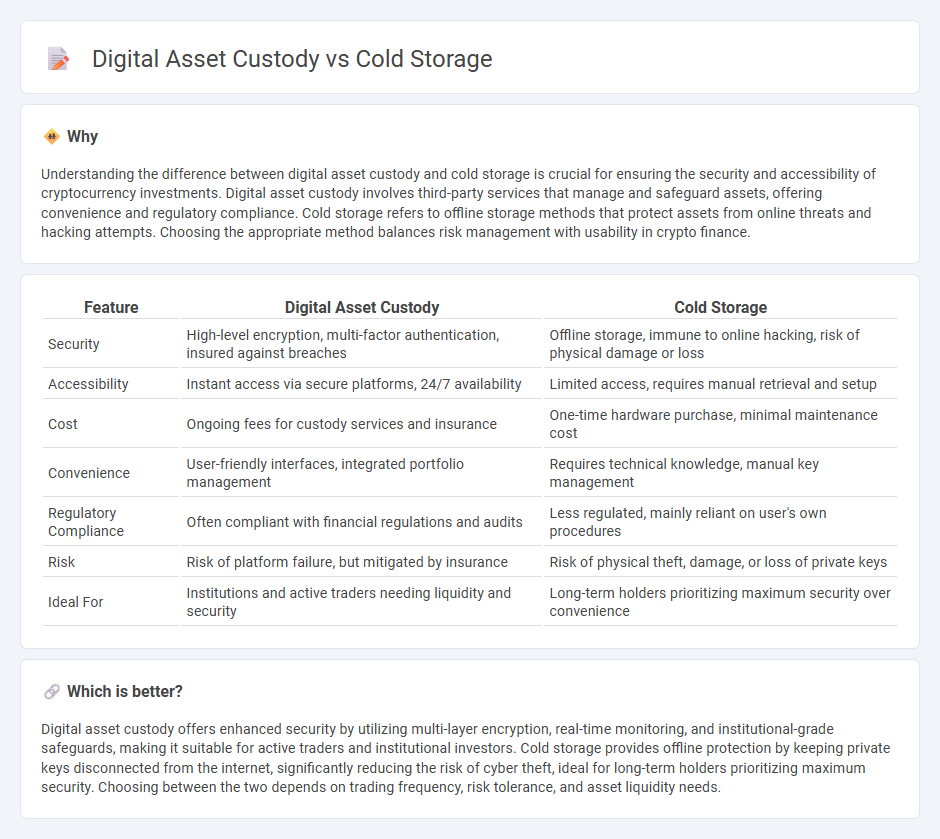
Digital asset custody provides secure, user-friendly solutions for managing cryptocurrencies via third-party services, ensuring regulatory compliance and reducing risk of theft. Cold storage involves offline wallets or hardware wallets that keep private keys disconnected from the internet, maximizing protection against hacking but requiring personal management competence. Explore more to understand which method suits your investment strategy best.
Why it is important
Understanding the difference between digital asset custody and cold storage is crucial for ensuring the security and accessibility of cryptocurrency investments. Digital asset custody involves third-party services that manage and safeguard assets, offering convenience and regulatory compliance. Cold storage refers to offline storage methods that protect assets from online threats and hacking attempts. Choosing the appropriate method balances risk management with usability in crypto finance.
Comparison Table
| Feature | Digital Asset Custody | Cold Storage |
|---|---|---|
| Security | High-level encryption, multi-factor authentication, insured against breaches | Offline storage, immune to online hacking, risk of physical damage or loss |
| Accessibility | Instant access via secure platforms, 24/7 availability | Limited access, requires manual retrieval and setup |
| Cost | Ongoing fees for custody services and insurance | One-time hardware purchase, minimal maintenance cost |
| Convenience | User-friendly interfaces, integrated portfolio management | Requires technical knowledge, manual key management |
| Regulatory Compliance | Often compliant with financial regulations and audits | Less regulated, mainly reliant on user's own procedures |
| Risk | Risk of platform failure, but mitigated by insurance | Risk of physical theft, damage, or loss of private keys |
| Ideal For | Institutions and active traders needing liquidity and security | Long-term holders prioritizing maximum security over convenience |
Which is better?
Digital asset custody offers enhanced security by utilizing multi-layer encryption, real-time monitoring, and institutional-grade safeguards, making it suitable for active traders and institutional investors. Cold storage provides offline protection by keeping private keys disconnected from the internet, significantly reducing the risk of cyber theft, ideal for long-term holders prioritizing maximum security. Choosing between the two depends on trading frequency, risk tolerance, and asset liquidity needs.
Connection
Digital asset custody involves securely managing and storing cryptocurrencies and tokens, with cold storage serving as a critical method by keeping private keys offline to protect against cyber threats. Cold storage solutions, such as hardware wallets and air-gapped computers, significantly reduce the risk of hacking and unauthorized access by isolating assets from internet exposure. Effective digital asset custody strategies leverage cold storage to ensure long-term security and regulatory compliance in the evolving financial landscape.
Key Terms
Private Keys
Cold storage provides offline security for private keys by isolating them from internet access, significantly reducing the risk of hacking or unauthorized digital breaches. Digital asset custody often involves third-party services managing private keys with multi-signature and encryption technologies to balance accessibility and protection. Explore deeper insights into private key management strategies to enhance your digital asset security.
Multi-signature
Multi-signature technology enhances digital asset security by requiring multiple private keys to authorize transactions, significantly reducing the risk of unauthorized access. Cold storage, which involves keeping assets offline, pairs effectively with multi-signature wallets to provide an extra layer of protection against cyber threats. Explore how combining cold storage and multi-signature custody solutions can safeguard your digital assets more efficiently.
Offline Storage
Cold storage refers to offline storage methods for cryptocurrencies, such as hardware wallets and paper wallets, which keep private keys disconnected from the internet to prevent hacking. Digital asset custody involves third-party services that securely store digital assets using a combination of offline and online strategies, with offline storage providing a critical security layer against cyber threats. Explore comprehensive guides on cold storage and digital custody solutions to enhance your understanding of secure digital asset management.
Source and External Links
Cold Storage Facilities: Everything You Need To Know - Cold storage facilities use advanced refrigeration systems to maintain low temperatures for preserving perishables and sensitive materials, regulating temperature, humidity, and air circulation to extend freshness and safety.
West Coast Cold Storage - A state-of-the-art 3PL cold storage facility in Southern California offering frozen and chilled storage with certifications including SQF and organic, providing services like bulk/rack storage, temperature-controlled loading docks, and customized logistics solutions.
United States Cold Storage - Industry-leading cold storage provider with cutting-edge technology and infrastructure ensuring optimal product preservation and efficient distribution, supported by highly skilled personnel and top safety standards.
 dowidth.com
dowidth.com